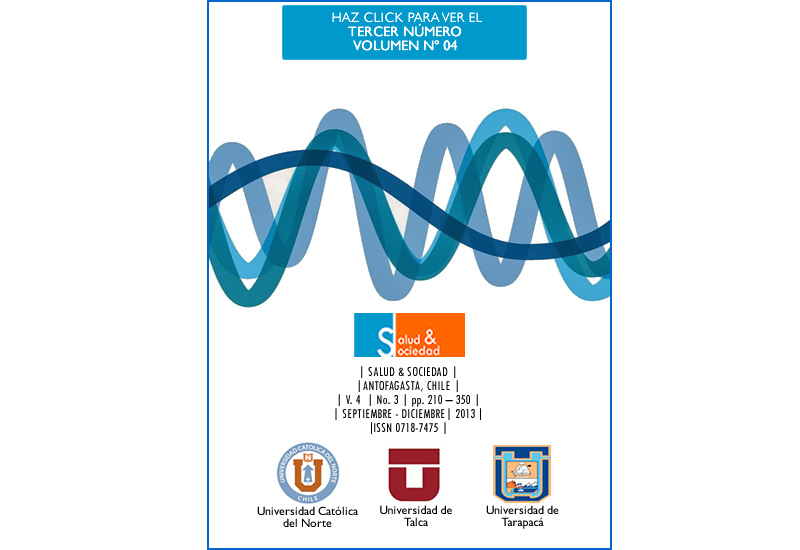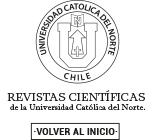Propiedades psicométricas de la escala de evaluación de la homofobia externalizada en estudiantes de ciencias de la salud mexicanos.
DOI:
https://doi.org/10.22199/S07187475.2013.0003.00002Palavras-chave:
Homofobia, homonegatividad, actitud, orientación sexual, Homophobia, homonegativity, attitude, sexual orientation,Resumo
Este artículo tiene como objetivos estudiar la consistencia interna, estructura factorial, distribución, validez convergente y de constructo de la Escala de Homofobia (HF) de Klamen, Grossman y Kopacz (1999) y estimar el porcentaje de casos de homofobia externalizada. Las Escalas HF, de Actitud hacia Lesbianas y Gais (ATLG) y Homonegatividad Internalizada (HIN-16) fueron aplicadas a una muestra no probabilística de 231 estudiantes mexicanos de ciencias de la salud (121 mujeres y 103 hombres). La Escala de Homofobia reducida a 8 ítems (HF-8) tuvo una estructura unidimensional, consistencia interna alta, validez convergente (correlación alta con rechazo abierto hacia la homosexualidad y moderada con rechazo sutil) y validez de constructo (medias de los participantes no heterosexuales y con amigos gais o con VIH significativamente menores que las de los participantes heterosexuales y sin amistades gais o con VIH). La distribución siguió a una curva normal. El porcentaje de casos de homofobia externalizada fue menor que 1. Se concluye que la Escala HF-8 es confiable y válida y el nivel de homofobia externalizada es bajo. Se sugiere usar la Escala HF-8 para evaluar homofobia externalizada en estudiantes mexicanos de ciencias de la salud y estudiar sus propiedades psicométricas en otras poblaciones
The aims of this paper are to study the internal consistency, factor structure, distribution, convergence validy, and construct validity of the Klamen, Grossman and Kopacz (1999) Homophobia (HF) Scale, and to estimate the percentage of cases of externalized homophobia. The HF Scale, the Attitude Toward Lesbians and Gay Men Scale, and the Internalized Homonegativity Scale were applied to a non-probability sample of 231 Mexican health sciences students (121 women and 103 men). The Homophobia Scale reduced to 8 items (HF-8) had unidimensional structure, high internal consistency, convergent validity (high correlation with open rejection of homosexuality and moderate correlation with subtle rejection of homosexuality), and construct validity (the means of the non-heterosexual and those having gay or HIV-infected friends were significantly lower than the means of heterosexual persons and participants not having gay or HIV-infected friends). HF-8 total score distribution followed a normal curve. The percentage of cases of externalized homophobia was lower than 1. It is therefore concluded that HF-8 Scale is a reliable and valid instrument, and that the level of externalized homophobia is low. Use of the HF-8 Scale is suggested for the assessment of externalized homophobia in Mexican health sciences students, and further study is recommended to study its psychometric properties in other populations.
Downloads
Referências
Arnold, L. M. (2001). Promoting culturally competent care for the lesbian, gay, bisexual, and transgender population. American Journal of Public Health, 91(11), 1731. http://dx.doi.org/10.2105/AJPH.91.11.1731
Campo, A. y Herazo, E. (2008). Homofobia en estudiantes de medicina: Una revisión de los diez últimos años. Medunab, 11(1), 120-123.
Campo, A., Herazo, E. y Cogollo, Z. (2010). Homofobia em estudantes de enfermagem. Revista da Escola de Enfermagem da USP, 44(3), 839-843.
Cárdenas, M. y Barrientos (2008). Actitudes explícitas e implícitas hacia los hombres homosexuales en una muestra de estudiantes universitarios en Chile. Psykhe, 17(2), 17-25. http://dx.doi.org/10.4067/S0718-22282008000200002
Centro Nacional para la Prevención y el Control del SIDA (2012). VIH/SIDA en México 2012. México, DF: CENSIDA.
Cragg, J. G. (1983). More efficient estimation in the presence of heteroscedasticity of unknown form. Econometrica, 51, 751-764. http://dx.doi.org/10.2307/1912156
Cronbach, L. J. y Shavelson, R. J. (2004). My current thoughts on coefficient alpha and successor procedures. Educational and Psychological Measurement, 64, 91-418. http://dx.doi.org/10.1177/0013164404266386
Currie, M. R., Cunningham, E. G. y Findlay, B. M. (2004). The Short Internalized Homonegativity Scale: Examination of the factorial structure of a new measure of internalized homophobia. Educational and Psychological Measurement, 64(6), 1053-1067. http://dx.doi.org/10.1177/0013164404264845
Feldman, T. B., Bell, R. A., Stephenson, J. J. y Purifoy, F. E. (1990). Attitudes of medical school faculty and students toward acquired immunodeficiency syndrome. Academic Medicine, 65, 464-466.
Herdt, G. y van-de-Meer, T. (2003). Homophobia and anti-gay violence -Contemporary perspective. Culture, Health and Sexuality, 5(2), 99-101. http://dx.doi.org/10.1080/136910501164128
Herek, G. M. (1984). Attitudes toward lesbians and gay men: A factor analytic study. Journal of Homosexuality, 10(1/2), 39-51. http://dx.doi.org/10.1300/J082v10n01_03
Herek, G. M. (2000a). The psychology of sexual prejudice. Current Directions in Psychological Sciences, 9(1), 19. http://dx.doi.org/10.1111/1467-8721.00051
Herek, G. M. (2000b). Sexual prejudice and gender: Do heterosexuals' attitudes toward
lesbians and gay men differ? Journal of Social Issues, 56(2), 251-266.
Herek, G. M. (2004). Beyond “homophobia”: Thinking about sexual prejudice and stigma
in the twenty-first century. Sexuality Research & Social Policy, 1(2), 6-24. http://dx.doi.org/10.1525/srsp.2004.1.2.6
Herek, G. M., Gillis, J. R. y Cogan, J. C. (2009). Internalized stigma among sexual minority adults: Insights from a social psychological perspective. Journal of Counseling Psychology, 56(1), 32-43 http://dx.doi.org/10.1037/a0014672
Herek, G. M. y McLemore, K. A. (2013). Sexual prejudice. Annual Review of Psychology, 64(1), 309-333. http://dx.doi.org/10.1146/annurev-psych-113011-143826
Hoburg, R., Konik, J., Williams, M. y Crawford, M. (2006). Bisexuality among self-identified heterosexual college students. Journal of Bisexuality, 4(1-2), 25-36. http://dx.doi.org/10.1300/J159v04n01_03
Klamen, D. L., Grossman, L. S. y Kopacz, D. R. (1999). Medical student homophobia. Journal of Homosexuality, 37, 53-63. http://dx.doi.org/10.1300/J082v37n01_04
Kline, R. B. (2010). Principles and practice of structural equation modeling (3ra. ed.). New York: The Guilford Press.
Larsen, K. S., Reed, M. y Goffman, S. (1980). Attitudes of heterosexuals toward homosexuality: A Likert-type scale and construct validity. Journal of Sex Research, 16, 245-257.
Leiblum, S. R., Rosen, R. C., Platt, M., Cross, R. J. y Black, C. (1993). Sexual attitudes and behavior of a cross-sectional sample of United States medical students: Effects of gender, age, and year of study. Journal of Sex Education and Therapy, 19, 235-245.
Mayer, K. H., Bekker, L. G., Stall, R., Grulich, A. E., Colfax, G. y Lama, J. R. (2012). Comprehensive clinical care for men who have sex with men: an integrated approach. Lancet, 380(9839), 378-387. http://dx.doi.org/10.1016/S0140-6736(12)60835-6
McGrory, B. J., McDowell, D. M. y Muskin, P. R. (1990). Medical students’ attitudes toward AIDS, homosexual, and intravenous drugabusing patients: A re-evaluation in New York City. Psychosomatics, 31, 426-433.
Moss, D. (2002). Internalized homophobia in men: wanting in the first person singular, hating in the first person plural. Psychoanalytic Quarterly, 71, 21-50. http://dx.doi.org/10.1002/j.2167-4086.2002.tb00003.x
Moral, J. (2006). Análisis factorial confirmatorio. En R. Landero y M. T. González (Eds.), Estadística con SPSS y metodología de la investigación (pp. 445-528). México, DF: Trillas.
Moral, J. y Valle, A. (2011). Escala de Actitudes hacia Lesbianas y Hombres Homosexuales en México 1. Estructura factorial y consistencia interna. Revista Electrónica Nova Scientia, 3(2), 139-157.
Moral, J. y Valle, A. (2012). Escala de Actitudes hacia Lesbianas y Hombres Homosexuales (ATLG) 2. Distribución y evidencias de validez. Revista Electrónica Nova Scientia, 4(1), 153-171.
Moral, J. y Valle (2013). Dimensionalidad, consistencia interna y distribución de la Escala Homonegatividad Internalizada en estudiantes mexicanos de ciencias de la salud. Acta Mexicana de Psicología, 3(1), 22-50.
Morrison, M. y Morrison, T. (2002). Development and validation of a scale measuring modern prejudice toward gay men and lesbian women. Journal of Homosexuality, 43(1), 15-37. http://dx.doi.org/10.1300/J082v43n02_02
Parker, A. y Bhugra, D.(2000). Attitudes of British medical students towards male homosexuality. Sexual and Relationship Therapy, 15(2), 141-149.
Preacher, K. J. y Coffman, D. L. (2006). Computing power and minimum sample size for RMSEA [Computer software]. Disponible en: http://quantpsy.org/rmsea/rmsea.htm
Quiles, M. N., Betancor, V., Rodríguez, R., Rodríguez, A. y Coello, E. (2003). La medida de la homofobia manifiesta y sutil. Psicothema, 15(2), 197-204.
Rosario, M., Schrimshaw, E. W., Hunter, J. y Braun, L. (2006). Sexual identity development among gay, lesbian, and bisexual youths: Consistency and change over time. Journal of Sex Research, 43(1), 46-58. http://dx.doi.org/10.1080/00224490609552298
Rowen, C. J. y Malcolm, J. P. (2002). Correlates of internalized homophobia and homosexual identity formation in a sample of gay men. Journal of Homosexuality, 43(2), 77-92. http://dx.doi.org/10.1300/J082v43n02_05
Sartori, R. (2006). The bell curve in psychological research and practice: myth or reality? Quality and Quantity, 40, 407- 418. http://dx.doi.org/10.1007/s11135-005-6104-0
Savin, R. C. y Ream, G. L. (2007). Prevalence and stability of sexual orientation components during adolescence and young adulthood. Archives of Sexual Behavior, 36, 385-394.
Skinner, C., Henshaw, P. y Petrak, J. (2001). Attitudes to lesbians and homosexual men: Medical students care. Sexually Transmitted Infections, 77(2), 147-148.
Sociedad Mexicana de Psicología (2007). Código ético del psicólogo (4ta. ed.). México, DF: Editorial Trillas.
SPSS Incorporation (2007). The SPSS base 16.0. User’s guide. Chicago, IL: SPSS Inc.
Turner, J. C. (1987). A Self-Categorization Theory. En J. C. Turner, M. Hogg, P. J. Oakes, S. D. Reicher y M. S. Wetherell, (Eds.), Rediscovering the social group: A self-categorization theory (pp. 117-141). Oxford, UK: Basil Blackwell.
Weinberg, G. H. (1972). Society and the healthy homosexual. New York: St. Martin's.
Young, F. W. (2010). ViSta “The Visual Statistics System”, version 7.9.2.5 [computer software] [on-line]. Disponible en: http://www.visualstats.org
Downloads
Publicado
Edição
Seção
Licença
Los autores continúan como propietarios de sus trabajos, y pueden volver a publicar sus artículos en otro medio sin tener que solicitar autorización, siempre y cuando indiquen que el trabajo fue publicado originariamente en Revista Salud & Sociedad (ISSNe:0718-7475).



_(1).png)





